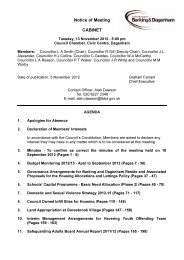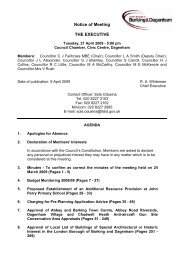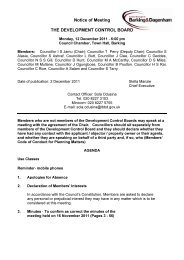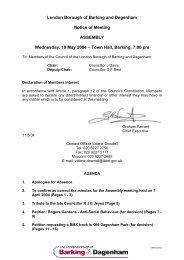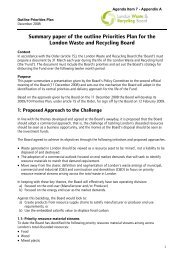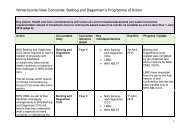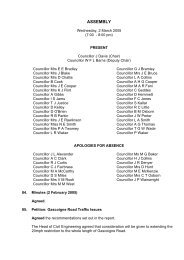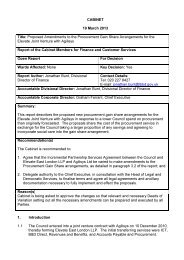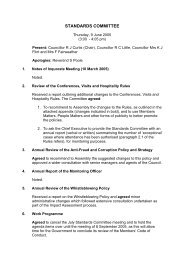Budget Strategy 2013-14 PDF 220 KB - London Borough of Barking ...
Budget Strategy 2013-14 PDF 220 KB - London Borough of Barking ...
Budget Strategy 2013-14 PDF 220 KB - London Borough of Barking ...
Create successful ePaper yourself
Turn your PDF publications into a flip-book with our unique Google optimized e-Paper software.
are not cash collection issues. However under universal credit the payments will go<br />
direct to the claimants, who in turn will be responsible for paying the authority as the<br />
landlord. Therefore the Authority will now be collecting money from current housing<br />
benefit claimants for the first time and will need to consider the impact on collection<br />
rates and provision for bad debt. This could be a significant pressure for the HRA<br />
on housing rent and the General Fund on temporary accommodation income.<br />
3.4.3 The reforms also includes introducing a £500 per week cap on housing benefit,<br />
which could see a movement <strong>of</strong> claimants from inner <strong>London</strong>, i.e. from more<br />
expensive properties that exceed the cap, outwards towards LBBD.<br />
3.5 Community Infrastructure Levy (CIL)<br />
3.5.1 The CIL is a new charge which local authorities are empowered, but not required, to<br />
levy on most types <strong>of</strong> new development in their areas. It will largely replace current<br />
Section 106 (S106) agreements with developers S106 will still continue to exist but<br />
to a much lesser extent and only in very specific areas. The CIL is charged in<br />
respect <strong>of</strong> the net additional floor space for all development within the <strong>Borough</strong>,<br />
excluding affordable housing. There are a range <strong>of</strong> set charges according to the<br />
type <strong>of</strong> development (including retail, leisure, health and education), which will<br />
reflect the desirability for each type, and ensure that desired new development is<br />
not deterred. This year the Authority has been consulting on its proposed charges,<br />
which have been agreed by Cabinet, and it is anticipated that the schemes will be<br />
implemented from the 1 st April <strong>2013</strong> though the Government may still delay the<br />
introduction. Unlike S106, CIL will not be negotiated on a development by<br />
development basis, which will make the process easier and more transparent. The<br />
CIL is also more flexible in terms <strong>of</strong> use whereas S106 receipts <strong>of</strong>ten had very strict<br />
contractual conditions over their use, CIL instead will just be added to the Councils<br />
overall funding for capital infrastructure.<br />
3.5.2 In addition, from the 1 st April 2012 the Council has been collecting a mayoral CIL,<br />
which is collected and passed on to the Mayor <strong>of</strong> <strong>London</strong>. We have been required<br />
to charge developers a standard rate <strong>of</strong> £20 per square metre <strong>of</strong> new development<br />
(the lowest <strong>of</strong> three bands across <strong>London</strong>). The Mayoral CIL was specifically set up<br />
to fund the Crossrail project, and once Crossrail is completed (by c2019), the<br />
charges will cease, at which time we could stop charging developers or subsume<br />
the charge into our own charges.<br />
3.6 Community Right to Buy<br />
3.6.1 The Localism Act 2011 contained provisions for assets whose main use furthers the<br />
social wellbeing or social interests <strong>of</strong> the local community (assets <strong>of</strong> community<br />
value). The provision relates to public and private assets and could be village<br />
shops, pubs, community centres, libraries and allotments.<br />
3.6.2 The provisions give local groups a right to nominate a building or land for listing by<br />
the Council as an asset <strong>of</strong> community value. When a listed asset is to be sold, local<br />
community groups will in many cases have a fairer chance to make a bid to buy it<br />
on the open market. Local groups will be given 6 months in which to prepare their<br />
<strong>of</strong>fer before the asset is allowed to be sold. However it is entirely down to the seller<br />
as to whom they sell their asset to.



